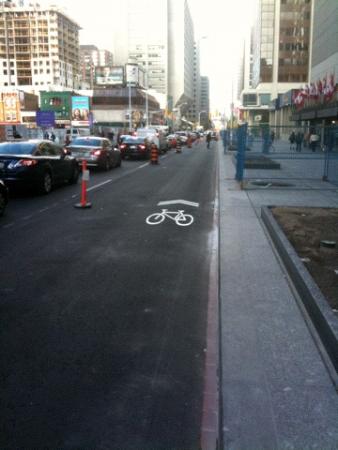Following is a well-thought out essay from reader Kevin. Give him your thoughts:
I extend my left arm. It’s the morning rush, and I’m on a bicycle. There are cars all around me. I’m doing a good clip, and approaching a set of traffic lights. In the lane adjacent to the one I’m in, and riding a few metres back there is a black BMW. The lady driving the beamer, probably in her mid 40’s, holding a Starbucks mint mocha Frappuccino and clad in gym attire is initially surprised by my actions and slows. I begin to inch over to the other lane, preparing for my turn. Realizing my intentions, and seeing that her God-given right to catch the green before it turned yellow would soon be abolished, she puts her foot down. She guns it. The noise from the engine is as loud as a city bus at full acceleration. I retract my arm quickly and my handlebars miss the metal box by all of 10 centimetres. Any closer and I would have replaced the BMW hood ornament with my body.
As a full time cyclist, and sometimes as a pedestrian, I have to deal with cars and their drivers every day. I am disgusted by drivers of private motor vehicles. Their actions infuriate me. A very high percentage of the drivers I see on the roads of Toronto are dangerous and inconsiderate, impatient, and grossly undereducated. A world with fewer or no cars would be many steps forward in the right direction.
Drivers are often inconsiderate and create risky situations for other road users. It fascinates me how urban planners ever even conceived of mixing cars, pedestrians and cyclists all in the same space. 150 pound persons are forced to share the road with 2000+ pound automobiles travelling many times faster. In a collision, the car will always win. Yet some drivers simply ignore that truth. The onus is on the drivers of motor vehicles to ensure the safety of all other road traffic. Often, during my commutes by bicycle, I have been very closely tailgated by cars. If I were to suddenly brake, or spill, I could be seriously maimed or killed. On other occasions, I have been squeezed out into parked cars on residential streets by drivers who pass without due consideration to cyclists. Cyclists and pedestrians are the most vulnerable users of the road network; we deserve to be respected to the utmost degree.
Speaking of passing too closely, the Highway Traffic Act of Ontario (the HTA) states that “[bicycles] may occupy any part of a lane when [their] safety warrants it.” Many drivers don’t know this, and believe cyclists should stay well to the right of the road at all costs so that they can pass in the same lane. In fact, this is a very hazardous practice, and my number one gripe with concern to motorists. It’s as if some drivers don’t even acknowledge our presence. Many are just too impatient to spare 3 seconds of their commute to change lanes and ensure the life of someone on foot or on a bike. A few odd drivers have even come so far as to honk me off the road and order me to ride on sidewalk, which is illegal. Another driver decided to give me an earful of sound because I was walking across the street too slowly. I was crossing at the lights, and had the right of way.
Drivers are severely undereducated. The graduated licensing system employed here in Ontario doesn’t do enough to prevent inexperienced and/or careless drivers from using the road network. The Driver’s Handbook, which is required reading for the earning of a license, has limited information on how drivers should treat cyclists and pedestrians. Also, most drivers forget these rules within years of learning them, leaving only their best guesses, or common judgment to guide them – a lot of which is wrong. For example, the law states that drivers going in both directions on a road must stop when someone is crossing at a crosswalk, and can only continue when that person has made it safely to the other side, not simply past the median or yellow line. Drivers are also largely unaware of the safety hazard they present to cyclists when they carelessly fling open their car doors. The “door prize” is an accident that can be avoided if drivers check their mirrors before stepping out of their cars.
In today’s North American transportation climate the car is still king. The tides will change however – as gas prices rise, as congestion increases, and as more people adopt a more sustainable lifestyle, walking and cycling will be seen as very viable alternatives. But for now, being a pedestrian or especially a cyclist can be very intimidating. Drivers operate dangerous vehicles, are often inconsiderate towards the needs of others, are discourteous and impatient, and at times, oblivious. Drivers grind my gears. Now and then, while cycling, I dream about what a car-free world would look like. The next moment, my thoughts are interrupted by an idiot who is attempting to squeeze me off the road. I carry a pen and paper for instances like this. The police help me out.


